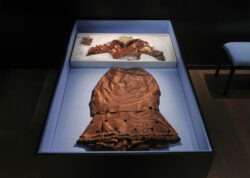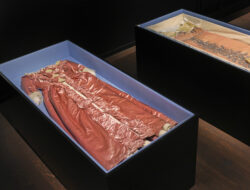SAFESILK: Conserving and Exhibiting Weighted Silks

To give silk more body, metal salts were often added from the 19th century onwards. Today, these weighted silks are known as some of the most rapidly deteriorating materials in heritage collections. Through the SAFESILK project, the University of Antwerp, in collaboration with the University of Ljubljana, aims to develop effective treatments for affected objects. As a partner, MoMu contributed several collection pieces as case studies.

"To properly assess the conservation challenges posed by weighted silk, we need access to damaged items," explains researcher Alina Krotova. "By studying a wide range of silk objects, we’re building a database that allows us to trace connections between historical periods, weighting techniques and patterns of damage. The samples from MoMu’s collection form the backbone of our research."
"The expertise of MoMu team members Kim Verkens and Pieters Pauwels is crucial. By making the museum collection accessible, we gain insight into the differences in preservation between weighted and non-weighted silk. The experience of the textile conservator and depot manager complements our chemical analyses perfectly in identifying the causes of degradation and how best to conserve weighted silk."

Alternative conservation methods
"Before we can propose optimal and effective conservation strategies, we first need to untangle the most influential ‘threads’ in the web of degradation factors," Krotova continues. "By combining observations of both historical and lab-developed weighted fabrics, we gain insight into the various stages and mechanisms of deterioration. We consider every possible process the silk has undergone—from the silkworm’s production to industrial treatments and the garment’s eventual use."
"Although we still can’t say with certainty which type of weighting is most harmful, we can already identify the pieces most at risk and in need of immediate attention from conservators. In future, some items may need to be stored without oxygen, in darkness or under specific humidity conditions."

Informed decisions
"In our search for alternative conservation treatments, we’re planning tests with biopolymers," adds co-researcher Chiara Vettorazzo. "These may serve as strengthening agents for extremely fragile silk. But it remains a delicate balancing act, especially when you consider that these beautiful objects are made of organic material that will inevitably degrade."
"Beyond storage conditions, we’re also investigating what conservators should consider when exhibiting these historical pieces. Knowing which objects require more careful handling or closer monitoring will help them decide what to show and what to protect. Since we can only slow down the degradation process—not stop it entirely—conservators will sometimes have to weigh whether exposure is worth the risk."


